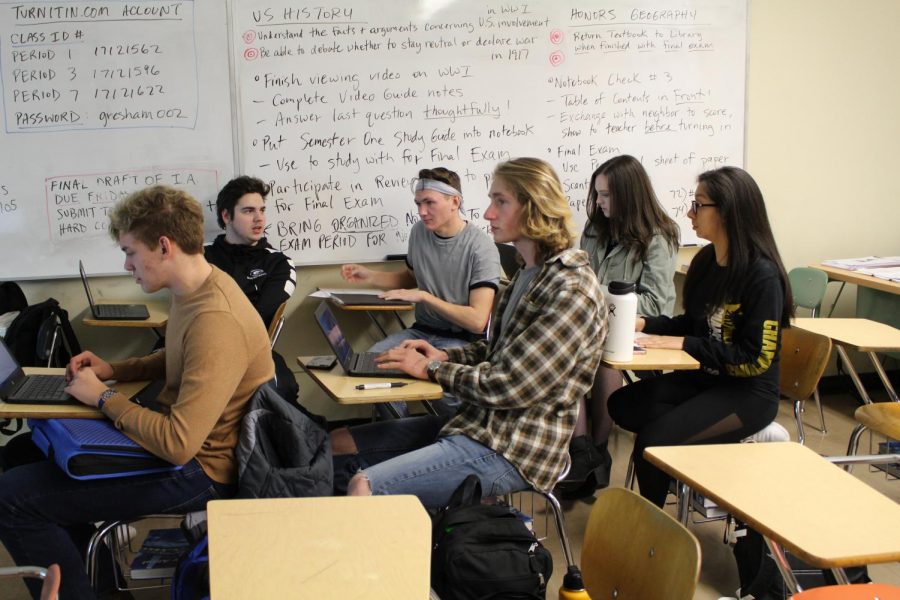A look into the whiteness of an IB Higher Level classroom
A group of seniors in Bart Walker’s seventh period IB World History HL2 class submit their Internal Assessments for grading. Walker’s seventh period class is approximately 11/14, or 78.6% white.
February 27, 2018
Gresham is one of the few high schools in Oregon that offers International Baccalaureate courses. International Baccalaureate, abbreviated to IB, is a series of courses related to core subjects that promote looking into views outside of your own country. IB programs are offered all across the world.
If content in IB classes is taught to students worldwide, who come from different cultures and countries, then why are the IB classes here so white?
“(The racial disparity) is certainly something we as a staff are attentive to,” English teacher Elizabeth Corum said. “One can notice that there’s not parity between our demographics as a school and our demographics in our HL classes.”
Corum’s first period IB Literature HL2 class counted in at 67% white at the end of first semester. Corum did note that because the higher level (HL) classes are so small to begin with, the difference between 60% and 67% could be one or two students.
“The learning environment is certainly impacted by a lack of equity,” Corum said. “That tends to self-perpetuate concepts of who belongs and who doesn’t belong in various spaces within our school, including academic or intellectual spaces.”
Corum goes on to explain that she tries to create a welcoming environment, and she hopes that other students try to make learning spaces welcoming for their peers. She points out though that students have already formulated beliefs that determine who they feel does or does not belong in a certain space.
This may be seen in STEM-related IB classes. Compared to Corum’s Lit class, the IB Biology HL2 sixth period class was 83% white students first semester.
“Many people of color are not seen in science fields compared to white people,” senior of color Robert Harris said. “Speaking on my behalf, I feel more comfortable in literature classes because there is more representation.”
When it comes to representation, though the students are not all too diverse, the teachers try to keep the coursework diverse.
For example, the Lit HL2 classes read The Fire Next Time at the start of the year. It is a memoir and essay by James Baldwin that addresses growing up as a black man in the civil rights era, and the experience of being a black man at that time. Harris praised this unit of study when asked about how the disparity affects the way material is taught.
Though higher level IB classes are open to anyone who wishes to take them, maybe open enrollment is not enough. The English department took a step to push students to challenge themselves by making IB Literature and Language the baseline English path for juniors and seniors. This action went into effect last school year.
Harris encouraged students of color to push themselves if they feel they wish to go into higher level IB classes, especially if those classes will help chase their dreams in the long run.
“I believe everyone is capable of becoming what they want, but for some it takes a lot longer and it’s a lot harder,” Harris said. “But honestly, take the harder classes. Challenge yourself, don’t let others’ views limit your opportunities.”

Ed Sage • Feb 28, 2018 at 4:05 pm
Thank you so much for writing about this issue.